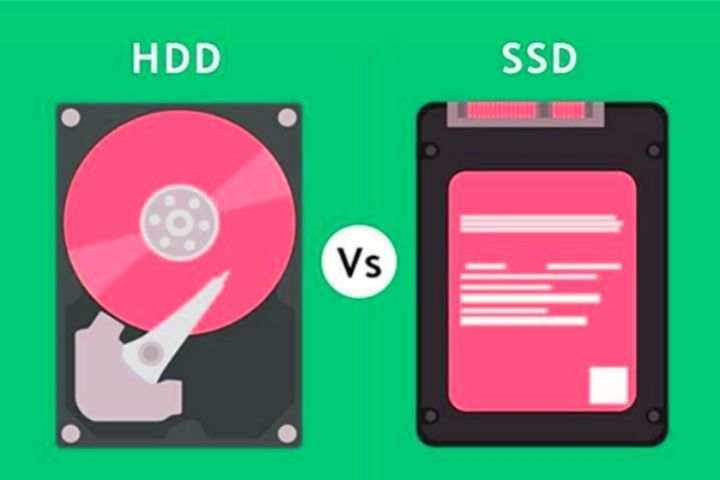SSD Vs HDD: The Main Differences

We’re explaining on SSD Vs HDD in this article. The exorbitant increase in the amounts of data we handle continually demands new solutions for its storage.
Already in 1956, IBM presented the first hard disk (Hard Disk Drive, abbreviated HDD) based on a magnetic memory whose storage capacity of 5 MB required at that time a mechanical body of 500 kilos. In 1980, Seagate released a 6MB HDD in a 5.25-inch device and priced at $1,000. It took 11 years to have the first 2.5-inch hard drives with a capacity of 100 MB.
At the same time the first solid state drives (SSD) with flash memory . Today, SSD drives have overtaken HDD hard drives in many sectors. However, the classic hard drive has not disappeared yet. We will tell you where it finds its reason for being and what differences there are between both technologies.
Table of Contents
Differences SSD-HDD: This Is How They Work
- Unlike an SSD drive, an HDD hard drive consists of discs or turntables that are magnetically charged and divided into tracks and sectors. The hard drive has a read / write head that is driven by the rotating magnetic platter. In this way, the information to be stored on the plates is written by magnetization. The different magnetic sectors are also read with the read / write head.
- In a simplified way, the reading operation can be compared to the operation of a vinyl player: once a title has been chosen from the index (record cover), the reading head (turntable needle) is placed in the space between two titles (data tracks) on the vinyl record to read the data (in our example, the music). If you want to hear another song, you have to repeat the process.
- In the case of the HDD, an interface and a connector are responsible for communication with the computer environment. The internal controller moves the read / write head towards the sector on the magnetic disk. Thus, the data remains stored on the HDD even if the power supply is interrupted.
- Unlike an SSD, building a HDD requires high precision mechanics. The magnetic memory disk sits on an axis and is driven by an electric motor at a defined rotational speed between 5400 and 15,000 revolutions per minute (the latter being the typical speed of high-performance computers and servers). A separate drive brings the read / write head to its working position, which demands high accuracy, as each data track measures only about 75 nanometers. The head is suspended in the rotating stream of air about 25 nanometers above the magnetic disk. By way of illustration: a human hair has a diameter of 300 nanometers. If the read / write head and the magnetic disk touch, a head break occurs with consequent loss of data.
- One obvious difference between an SSD and an HDD is that the SSD is not made up of moving mechanical parts or rotating magnetic disks, and it does not have a read / write head either. The data is stored in semiconductor cells , for which it takes advantage of the quality of a semiconductor (solid state) to be able to save (and maintain even without electricity) the states of charge.
- A controller is in charge of spreading the data across the several million semiconductor cells, in addition to stacking it in layers according to the requirements and moving it in case of need or risk of failure of the memory cells. With no electrically powered components, the SSD outperforms the HHD drive in terms of power demand. Also, the weight and size are less.
SSD Vs HDD: Lifespan Of Storage Technologies
- Among the many technical differences between HDD Vs SSD, the durability of each of these technologies is worth taking a look at. At present, mechanical solutions are highly developed, but they are also subject to natural wear and tear, mainly due to friction (otherwise, perpetual mobiles would exist).
- Therefore, the useful life of a hard disk is estimated between five and ten years , although it may be reduced depending on the thermal and mechanical load to which it is subjected. Some manufacturers promise an HDD life of up to one million hours (equivalent to approximately 114 years). There are many diagnostic programs that determine the health of a hard drive. To prolong its durability, the defragmentation at regular intervals is an important measure.
- On the other hand, the useful life of the SSD drive is usually indicated by the maximum total executable data capacity, which is measured in TBW (terabytes written). An example: the manufacturer sells an SSD for consumer use with a capacity of 240 gigabytes, a three-year warranty and a total data volume of 72 terabytes. If we do the math, we have 65 gigabytes per day. An ordinary desktop computer writes between 20 and 30 gigabytes a day. Therefore, this example of an SSD should have a durability of ten years . If you are working with video or image files, this volume would be consumed more quickly.
- Today’s professional-oriented SSDs reach up to five million write cycles , with an upward trend. Therefore, servers with SSD technology are the best storage option for the future, as they also reduce the energy demand of the servers and thereby minimize their ecological footprint.
- There are also monitoring programs for SSD drives with which to analyze the status of the drive. In addition, it is possible to update the firmware of an SSD drive to improve data management.
Also Read : All You Need To Know About Drones






